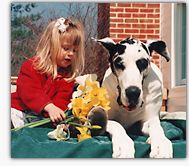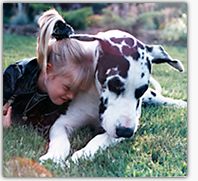|
– Broken Hearts,
Broken Dreams –
July 1, 2002 – Last
week we met Phlash, a 5-year-old fawn Great Dane who lost his
battle with dilated cardiomyopathy (DCM). This week you'll be meeting
Karen Quatman's Harley, who succumbed to DCM two years ago. He was
7 years old. Before we get to Harley's cardio story, which appears
below, I'd like to discuss certain aspects of the disease. Later
I will tell you about some efforts underway to better understand
DCM. Please keep in mind that what you read here is just a layman's
interpretation (my own). If you have questions and concerns about
your own dog, you should contact your veterinarian or a canine cardiologist
for more information.

 What
is dilated cardiomyopathy (DCM)? What
is dilated cardiomyopathy (DCM)?

Dilated cardiomyopathy (DCM) is a primary heart muscle disease.
It is progressive in nature and there is no cure. Dogs with undiagnosed
dilated cardiomyopathy can suddenly drop dead for no apparent reason.
Other DCM dogs may suffer from congestive heart failure and die
within months of their initial diagnosis. Many breeds of dogs are
stricken with DCM and the disease is somewhat different for each
breed. (Breed specific variations include age of onset, rate of
progression, type of arrhythmia, sudden death versus congestive
heart failure, etc.) Unfortunately, the Great Dane is reported to
be the second most common breed of dog afflicted with DCM,
second only to the Doberman.

Last year at the GDCA National Specialty I attended a lecture titled,
"Dilated Cardiomyopathy in the Great Dane." The lecture
was presented by Dr.
Kathryn M. Meurs, a professor of cardiovascular medicine at
Ohio State's College of Veterinary Medicine. Dr. Meurs is researching
the inheritance of cardiomyopathy and the use of molecular genetic
techniques to study both inherited and acquired cardiovascular disease.

According to Meurs, dilated cardiomyopathy
in the Great Dane is usually characterized by enlargement of the left
ventricle, decreased pumping ability and electrical abnormalities.
Clinical presentation in the early stages of DCM often goes undiagnosed.
A heart murmur may be heard on the left side and abnormal heart beats
may be observed during a routine electrocardiogram. An echocardiogram
may reveal mild leaking of the mitral valve and/or mild dilation of
the ventricle. As the condition advances, the dog may exhibit coughing
and shortness of breath, exercise intolerance, increased or decreased
rate of breathing and weight loss. An examining veterinarian will
often detect a heart murmur (very common), "gallop" heart
rhythm, and/or a rapid, irregular heart rate.

Advanced dilated cardiomyopathy is considered a fatal disease. Certain
medications can be used to help the dog remain comfortable. Digoxin
may be given to help the heart pump. Lasix may be given to reduce
fluid in the lungs. Enalapril, Lisinopril and/or Vasitec help with
heart failure and dilate blood vessels. But medicating and maintaining
a DCM patient the size of a Great Dane can be an expensive (and emotionally
draining) proposition; many pet owners can't afford to do so for very
long.

Living
(and dying) with DCM
Obviously, the "DCM experience" is not the same for
every dog and every family. Harley (pictured throughout this article)
was not the first Great Dane that Karen Quatman lost to DCM. He was
her third. I asked Karen to tell us about Harley's case:
|
Harley's Story
By Karen Quatman
 Harley
was born on October 18, 1992. He came into our lives as a 17-week-old
puppy when Harley’s breeder – my good friend
– asked us to babysit Harley while she was caring
for her sick child. We agreed. Shortly thereafter I called my
friend and told her we were in love with Harley and he was staying
forever. She readily agreed and we believe that was her plan
all along! Harley
was born on October 18, 1992. He came into our lives as a 17-week-old
puppy when Harley’s breeder – my good friend
– asked us to babysit Harley while she was caring
for her sick child. We agreed. Shortly thereafter I called my
friend and told her we were in love with Harley and he was staying
forever. She readily agreed and we believe that was her plan
all along!

One day when Harley was approximately 2 years old his breeder
called me, clearly upset. Harley’s father (age 5 1/2) was
extremely sick and the vet wanted her to get him to a cardiologist
as soon as possible. Could I recommend someone? We made an appointment
with a cardiologist who, from past experience, I knew to be
very good.The appointment was the next day. I offered to tag
along for moral support. I arrived at the clinic to find Harley’s
father lying on the floor on his right side. His breathing was
very labored. He was weak and made no attempt to rise when I
arrived. With every breath he took, you could hear fluid moving
around his lungs. Pneumonia. I knew it was bad. He was shocky.
An echocardiogram was given. Dilated cardiomyopathy was confirmed.
He was in congestive heart failure and the prognosis was poor.
He died months later.

Screening for DCM

Because Harley's father had DCM, I decided to take Harley in
for a screening. I had already lost my first two Danes to dilated
cardiomyopathy (fawn half-brothers, obviously not related to
Harley), so I was all too familiar with the disease. Harley
was examined. An innocent murmur was heard. DCM was ruled out
by an echocardiogram. We ran another echo three years later
when Harley was 5. The same results were found. Innocent murmur,
DCM ruled out by echocardiogram.

 In
December of 1998, when Harley was 6 years old, I started to
notice some changes in his breathing pattern. Sometimes while
he slept, I would hear a loud "snore" which would
be followed by a pause. I described it to my vet as something
similar to a sleep apnea. My vet performed a thorough exam and
found nothing. She told me I could take Harley back to the cardiologist
for a another screening if it was concerning me. Since everything
else appeared normal, I decided to wait and see. In
December of 1998, when Harley was 6 years old, I started to
notice some changes in his breathing pattern. Sometimes while
he slept, I would hear a loud "snore" which would
be followed by a pause. I described it to my vet as something
similar to a sleep apnea. My vet performed a thorough exam and
found nothing. She told me I could take Harley back to the cardiologist
for a another screening if it was concerning me. Since everything
else appeared normal, I decided to wait and see.

A month later, in January of 1999, I received a call from a
woman who owned Harley’s 3-year-old nephew. He was out
of Harley’s full sister. Harley's nephew had just been
diagnosed with dilated cardiomypathy, atrial fibrillation and
secondary valvular regurgitations. He was in bad shape. After
hearing this, I became hypersensitive to any change in Harley’s
health.

The warning signs

By March I knew Harley had it. For the life of me, I cannot
remember how I knew, or why I knew, but I knew.
It may have been the subtle changes. Those loud snore sounds
became more frequent. The pauses in his breathing more frequent.
Harley's heart rate remained normal but he was slowing down.
The black circles around his eyes grayed almost overnight. His
energy level dropped. He started missing meals, although he
was still a good weight. I already had an appointment to take
Harley in for a re-screeening in April. Unfortunately, that
same month, I lost my 3-year-old male suddenly and tragically
to complications from a neuter. I was devastated by the loss
and I just couldn’t bring myself to hear what I already
knew, so I postponed Harley's appointment for a month.

 Diagnosis
and treatment
Diagnosis
and treatment

I
took Harley back to the cardiologist in June. I wasn't surprised
when he was diagnosed with dilated cardiomyopathy. (Moderate
DCM, 14% fractional shortening.) I made the decision to wait
three weeks before starting Harley's medication. Why? We were
going on vacation. A previous cardio dog of mine had a toxic
reaction to Digoxin and I didn’t want to take the chance
that Harley might have one, too. So we waited until we came
home to start the Digoxin and Zestril. In the interim, Harley
was on 2 grams of carnitine twice a day. He was also getting
1000 IU of vitamin E, 220 mg of CoQ-10, probiotics, digestive
enzymes and milk thistle. Harley started a downhill spiral shortly
after we returned from vacation. In that short amount of time
he developed hind-leg edema. His thighs were double their normal
size. He was completely exercise intolerant. His tongue was
blue. His groin was puffy with fluid. He was over-consuming
water due to the Lasix and would often cough and gag.

For the next 11 months Harley had his ups and downs. There were
times when we didn’t think he would make it through the
night. Then he would rally. Then he would crash. Then he would
rally. It was a constant roller coaster ride for all of us.

 Saying
goodbye Saying
goodbye

Our decision to say goodbye was not an easy one. I kept thinking
that he had a history of rallying before and maybe he could
rally again. Deep down in my heart, I knew he couldn’t
– and frankly, I don’t think Harley wanted
to rally anymore. It was painful to watch him breath while he
slept. His breathing was so labored. He was tired. He had fought
a good fight. As much as I didn’t want to accept it, Harley
let me know it was time to let go. He didn’t deserve to
suffer needlessly. He deserved a dignified end. Harley was euthanised
in his own home, on his bed, surrounded by the people who loved
him. We miss him so.


 –
Karen Quatman –
Karen Quatman
|

What
causes DCM in the Great Dane?

As we've seen, DCM hurts everyone it touches. So which dogs
get it, and why? There are no definitive answers to that question.
A number of causes have been suggested ranging from parvovirus to
specific nutritional deficiencies. According to Dr. Meurs, there
is no evidence that parvo is implicated in the development of the
disease in Great Danes; molecular analysis has been performed to
look for it and no relationship has been found. She also states
that "there is no evidence that Taurine deficiency or L-Carnitine
deficiency is implicated in the development of dilated cardiomyopathy"
in the Great Dane. Dr. Meurs has found, however, persuasive evidence
that suggests DCM in Great Danes might be an inherited trait, more
specifically an X-linked recessive trait. If her preliminary research
proves true, the implications for both breeders and puppy buyers
could be enormous.

More to come...
Next week we'll look a little more closely at Dr. Meurs's research.
In the meantime, if you would like more information on the clinical
and practical aspects of DCM, the following links might be helpful:
 VetCentric
Pharmacy - article on DCM VetCentric
Pharmacy - article on DCM

 Canine
Inherited Disorders Database - article on DCM Canine
Inherited Disorders Database - article on DCM

 Petplace
- article on DCM Petplace
- article on DCM
For the record, some might disagree
with Dr. Meurs's comments on Taurine and L-Carnitine:

 University
of Parma (Italy): Dilated Cardiomyopathy University
of Parma (Italy): Dilated Cardiomyopathy
 in
a Family of Great Danes, Efficacy of Oral L-Carnitine in
a Family of Great Danes, Efficacy of Oral L-Carnitine

 UC
Davis: Dietary Taurine Deficiency and Dilated UC
Davis: Dietary Taurine Deficiency and Dilated
 Cardiomyopathy
in Dogs Cardiomyopathy
in Dogs
However, it pays to dig a little deeper
– as most dogs will tell you! Dr.
Mark Kittleson (UC Davis) ran a well-known study, the Multicenter
Spaniel Trial (Taurine- and carnitine-responsive dilated cardiomyopathy
in American cocker spaniels with decreased plasma taurine concentration).
He was later quoted as saying, "Taurine deficiency and taurine
and carnitine responsiveness are not totally limited to American
cockers since we do see it on occasion in other dogs, but we never
see it in the 'common' breeds that get DCM like Great Danes."
(For more information about the MUST (Multi Spaniel Trial) study
and the origin of Dr. Kittleson's comment about Great Danes, click
here.)
— ©2002 by
Ginnie
Saunders
<<
Previous installment || Next
installment >>
©2002-2008
by Ginnie Saunders. All rights are reserved. No part of this web
site
may be reproduced or transmitted in any form or by any means —
electronic or mechanical, including photocopying, recording, or by
any information storage or retrieval system — without written
permission from Ginnie
Saunders. To learn more about copyright issues on the web,
visit the Web Law
FAQ.
Ginnie.com, Inc.
PO Box 50314
Columbia, SC 29250
(803) 783-3169
www.ginnie.com
|


|

![]()





 In
December of 1998, when Harley was 6 years old, I started to
notice some changes in his breathing pattern. Sometimes while
he slept, I would hear a loud "snore" which would
be followed by a pause. I described it to my vet as something
similar to a sleep apnea. My vet performed a thorough exam and
found nothing. She told me I could take Harley back to the cardiologist
for a another screening if it was concerning me. Since everything
else appeared normal, I decided to wait and see.
In
December of 1998, when Harley was 6 years old, I started to
notice some changes in his breathing pattern. Sometimes while
he slept, I would hear a loud "snore" which would
be followed by a pause. I described it to my vet as something
similar to a sleep apnea. My vet performed a thorough exam and
found nothing. She told me I could take Harley back to the cardiologist
for a another screening if it was concerning me. Since everything
else appeared normal, I decided to wait and see.
 Saying
goodbye
Saying
goodbye